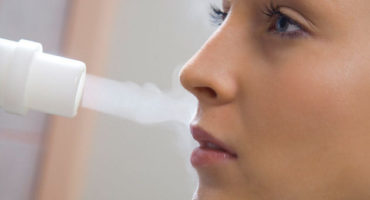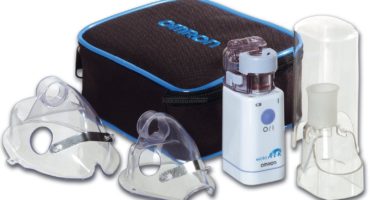Inhaler - what is it and how does an inhaler work? How to use an inhaler at home with cough, asthma, bronchitis.
Inhalation is considered the fastest and safest way to treat the respiratory system. With its help, medicinal substances go directly to the inflamed tissue, which greatly speeds up the process of therapy. The indisputable plus of inhalation is also that medicinal substances do not need to be taken through the gastrointestinal tract. Overcoming such a path, all kinds of tablets and syrups not only lose some of their beneficial properties until they reach the necessary organs, but also bring certain harm in the first place, to such organs as the stomach, liver and kidneys, which pass all substances through themselves.

Inhalers are a worthy replacement for the dangerous inhalation procedure over the pan.
Inhalation has been known to mankind since ancient times, even then healers suggested that patients breathe over herbal infusions. In the modern world, medicine has stepped far forward and now the medical equipment market offers a variety of inhalers for the treatment of various diseases. And clinic doctors are increasingly appointing patients with respiratory diseases, inhalation therapy.
What is an inhaler for and what is an inhaler
Before proceeding to the procedures, it is worth understanding what an inhaler is. This name originates in the Latin language, if translated literally, then the inhaler will mean inhale. So, an inhaler is a special device that directs medicinal substances into the body through the respiratory tract.
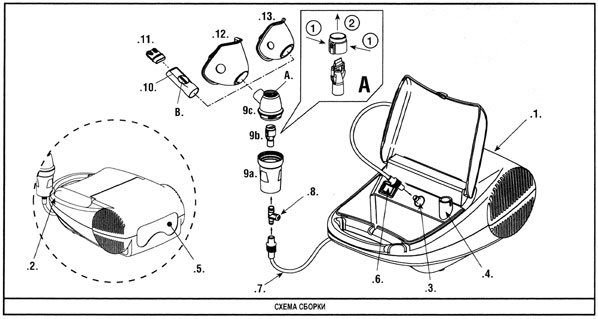
Schematic device of a nebulizer.
A nebulizer is a popular type of inhaler, its name also comes from the Latin language and translates as fog or cloud. The nebulizer operates on the same principle, the drug solution is converted into an aerosol using a special mechanism, which the patient needs to inhale.
These two devices have practically no differences, so basically their names are synonymous.
However, experts insist on the fundamental difference between an inhaler and a nebulizer. The fact is that the latter has a narrower specificity of application and affects most precisely the affected areas of the respiratory system. The quality of treatment depends on the size of the particles onto which the substance is sprayed, the smaller they are, the more effective the treatment will be. Therefore, vapor-based inhalers cannot be called a nebulizer, the rest can be called in any variation.
Why do I need an inhaler
Inhaler treatment has long been proven to be effective. Not surprisingly, inhalation helps to eliminate colds, cough and runny nose, moisturize the mucous membrane of the respiratory tract, thereby facilitating the patient's condition and removing phlegm. In addition, inhalation prevents or alleviates the symptoms of diseases such as bronchitis and asthma.

The process of formation of therapeutic aerosol.
The inhalation process allows the drug solution to enter the tissues of the most distant respiratory organs, which in turn contributes to the treatment of chronic diseases, influenza and SARS.

The nebulizer is suitable for the treatment of symptoms of colds and SARS.
Especially indispensable is an inhaler at home when there are small children.In case of colds, the device will be a real salvation, which will quickly cure the baby without side effects. Another plus of having an inhaler in home use is that it is possible to carry out medical procedures without leaving the apartment, which is important for mothers of young children, because it is better not to bring them to the hospital during illness, there is a big risk of complications for a weakened immune system. The treatment solution is quickly absorbed, which allows you to recover faster.
What diseases is an inhaler used for?
Inhalation procedures can be performed for a person of any age. This universal device is able to fight not only with colds, but also with asthma and diseases of the bronchi. Using a home inhaler makes the procedure more comfortable and safe.
The principle of operation of the inhaler is to continuously supply steam with the drug dissolved in it, the patient can only breathe them. So, inhalers are designed to fight diseases of the respiratory system of the body, and they can also be used for prevention. What diseases the modern nebulizer can cope with, the list of ailments is divided into several groups, each has its own characteristics:
- The first group. Complicated diseases accompanied by acute attacks requiring emergency care. This happens with asthma and allergic manifestations. For these diseases, an inhaler is the main way to relieve symptoms. The medicinal composition for the procedures is prescribed by an allergist.
- The second one. Chronic diseases such as bronchitis or rhinitis. Such diseases begin to develop from a very young age. Therefore, if a child often suffers from a cold, an inhaler in the house will be an indispensable way to strengthen the baby's health. Cough inhalation only accelerate the healing process in both adults and children. This happens because the drug substance passes directly to the inflamed areas.
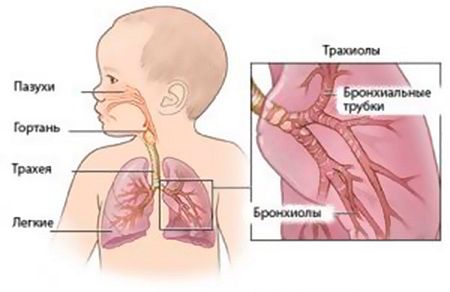
With bronchitis, inhalation therapy is often prescribed.
- The third. These are inflammatory processes of the respiratory tract, for example, pharyngitis, laryngitis and rhinitis.
- Fourth. These are diseases resulting from work in hazardous industries. For example, miners or chemical workers.
- Fifth. Patients with impaired immune, nervous, vascular systems.
It is worth more to examine in detail the question of which cough is recommended for inhaler therapy. Basically, inhalation is prescribed to soften a dry cough, which makes itself felt with a cold. Concomitant symptoms, usually dryness and inflammation of the tissues of the throat. The inhaler allows you to relieve swelling of the throat and also moisturize the tissues of the respiratory tract.

An inhaler can also cope with cough and sore throat.
Sputum cough is also treated with an inhaler. Here, the procedure is aimed at liquefying and removing viscous secretions from the lungs. Depending on the type of cough, the doctor prescribes a drug
How to use an inhaler
Before you start the procedure, you need to study inhaler rules. Hands must first be sanitized to prevent harmful bacteria from entering the medication. Next, the inhaler is assembled, as indicated in the instructions. Next, a solution is poured into a special container: first, saline is poured, and then the medicine. Pour the substance with a new syringe. After the preparation is completed, you can put on a mask and turn on the device. It is important to remember that the products used must be fresh, so before use it is worth paying attention to the expiration date.
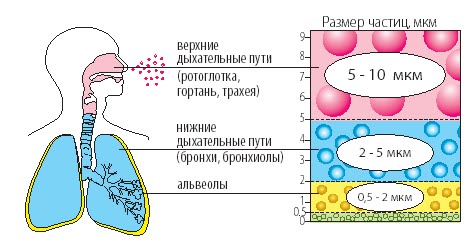
The figure shows what size particles fall into which area of the respiratory system.
The duration of the procedure lasts until the solution is completely dissolved, usually it takes about ten minutes. After the procedure is completed, you need to rinse the parts of the inhaler under a hot tap.No need to wash the parts with any sponges and brushes, a little washing up for dishes is enough. After thorough washing, the parts are dried and stored in a dry place inaccessible to children.
Rules for inhalation
After the first sessions, a visible result will appear. But, far from everyone knows how to properly administer therapy and use an inhaler. And this is necessary for a more effective and quick treatment. Below are some rules to consider:
- The session should begin no earlier than a couple of hours after eating and physical work.
- It is not recommended to talk.
- The patient should be dressed in clothes that do not restrain his neck, which would not impede the process of breathing.
- If possible, smoking should be excluded during the entire therapy, or at least not smoking an hour after.
- If therapy is used to treat a runny nose, inhale the aerosol through the nose.
- With bronchitis, tracheitis, tonsillitis and other inflammatory processes of the lower respiratory tract, you need to inhale by mouth. You need to breathe smoothly and calmly.
- Do not drink expectorants and do not use mouth products.
- At the end of inhalation, rinse your nose and mouth with cool water. In case of inhalation with a mask, also wash your face.
- You can eat half an hour after the procedure.
- Inhalation sessions with treatment solutions can be used no more than three times a day.

Smoking negatively affects the effect of inhaler treatment.
What medicines to use
Depending on what needs to be treated, the following solutions are recommended:
- To eliminate the common cold, it is enough to do inhalation with mineral water. This gentle method is great for babies and pregnant women. With a more acute manifestation of the common cold, you can use a solution using Furacilin.

A safe component that can be used for children and pregnant expectant mothers.
- Inhalation with saline or mineral water can help cough. If we talk about more serious drugs, then doctors prescribe Lazolvan, Ambrohexal and other means of the mucolytic group.
Drugs from the antibiotic group can not be taken without the recommendation of a doctor, otherwise you can only harm your health.
Contraindications for inhalation
Before resorting to inhalation procedures, it is worth paying attention to contraindications. Inhalation cannot be carried out with the following diseases in a patient:
- Frequent nosebleeds and diseases associated with bleeding in the lungs.
- Diseases of the nasopharynx with purulent discharge.
- Disorders of the cardiovascular system.
- Pathologies associated with the respiratory system.
In any case, each patient has his own characteristics of the body. Therefore, before using the inhaler, it is necessary to consult a doctor who will prescribe the correct treatment.

